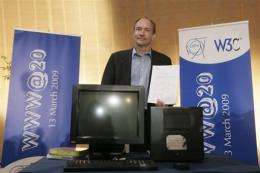www@20: How the techies tamed the cyber zoo

Huddled around a vintage computer, four of the creators of the world wide web were blissfully unaware of the audience as they demonstrated how, some 20 years ago, they spawned the exponential growth of the Internet.
In the atmosphere of a school reunion at the European Organisation for Nuclear Research (CERN) last week, the bright-eyed boys, now middle-aged, reminisced geekishly over computer programming.
Little pink windows popped up on screen and links were created, allowing them to click from one section to the next.
Yet, as impenetrable as the conversation seemed during the commemorative event, their aim in 1989 was to allow thousands of physicists from around the world to communicate and swap research on atom-smashing at a distance.
"We connected up the zoo of machines," explained Ben Segal, one of the programmers and engineers.
Personal computing was in its infancy in the 1980s: different computers often had their own incompatible and complex code-based operating systems or formatting, while networking was cumbersome.
On a now forgotten date in March 1989, Briton Tim Berners-Lee, then a consultant software engineer at CERN, handed his supervisor a proposal on "information management".
The original copy kept by Berners-Lee still has the response the supervisor, Michael Sendall, scribbled at the top of the page: "vague but exciting".
"Mike was the boss who didn't say no," said the Belgian former CERN systems engineer Robert Cailliau -- dubbed by his colleagues the "second user of the web".
"He was crucial to getting it going," added Cailliau.
The document advocating a universal system based on hypertext -- the programming language that allows links between pages on the web -- contained a complicated diagram with a circle marked "Mesh" in the centre.
"I thought of 'mesh', but it sounded too much like 'mess'," said Berners-Lee, who adopted the name World Wide Web in May 1990.
Rolf-Dieter Heuer, the new director general of CERN, was a German physicist at the laboratory straddling the Swiss-French border at the time.
"I just took it for granted, we didn't foresee the incredible phenomenon that it created."
The lab provided a "canvas" for early web development: it was staffed by engineers who were intent on problem-solving and they were often scattered around Europe and elsewhere.
And, unusually for the time, "there was a computer on every desk," Heuer pointed out.
The project's slogan was "let us share what you know". However, Berners-Lee, Cailliau, Segal and Jean-François Groff, a young programmer who was seconded to CERN as an alternative to military service in France, had some convincing to do.
"It was actually illegal until 1988 to 1989 to make an external connection from the lab," Segal said. "CERN is full of smart people with good ideas, and this was just another one."
It took more than a year for Berners-Lee to start developing the web browser. He remembers that when they demonstrated it by simply clicking on a link and a page appeared, the reaction was often a puzzled "so what?".
"After that it took off because people across the planet, random people, started to get involved," said Berners-Lee. "Universality, that was the rule, and it worked."
The key was the outward simplicity.
"The key invention is the URL (website address), it's the thing you can write on a napkin," said Groff.
The first server outside Europe, at the SLAC particle accelerator in California, was connected at the end of 1991.
Berners-Lee later pursued development in the United States and CERN released the software for free in the public domain in 1993.
"Back then there were 26 web servers, now there are 10 to the power 11 pages. That's as many as the neurones in your brain," said the Berners-Lee, now 53, who heads the World wide Web Consortium (3WC).
"The difference is that your neurones are going down and the web is growing."
Twenty percent of humanity is connected to the web, according to standard-setting authorities. It is used worldwide for personal communications, entertainment, knowledge, education, commerce, shopping and science, in the office, home and increasingly on the move.
Twenty years on -- six generations in the computer world -- it incorporates more than 30 software standards, as well as audio and video, and even live transmissions.
"The web is not all done. It?s just the tip of the iceberg," said Berners-Lee.
(c) 2009 AFP

















